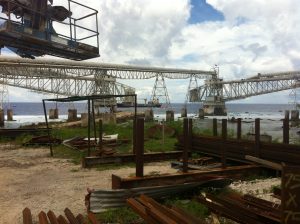21 Pacific Realm: Economic Geography – The Guano Economy
What does an albatross want? An albatross is a somewhat large seabird whose wingspan often is about ten feet across. Presumably, an albatross would like to have easy access to food such as small fish. The bird also would need a place to roost, rest, and breed. Theoretically, any coastal landscape could work. An island might do well. However, many coastal locations, islands or otherwise, have human populations. Let’s go find places to avoid predators, including no human predators. Historically, we are going back in time, past modern times where human settlements often have large quantities of garbage that might provide easy pickings for any birds, even those that usually eat fish. Isolated islands sound like good choices. Certainly there are islands throughout the oceans of the world. Even so, location still makes a difference. Frozen polar islands probably are not the best settings, although penguins do live at Antarctica. Fish do live in cold waters, but perhaps more abundantly in tropical zones. In the Pacific Ocean there are many tropical islands. Often these islands are uninhabited or at least spent thousands and thousands of years uninhabited before the Austronesian Expansion brought people to these Pacific isles.
Therefore, for at least some Pacific islands, seabirds like albatrosses lived on small Pacific islands, over generations of birds and for eons on these rocky sites. The birds ate fish from the water and pooped excrement from the skies. Some of this poop landed in the ocean, but other bits plopped onto the islands themselves. Or, the birds defecated while they walked on the land.
Who knows when animal manure first began to be use as fertilizer? Certainly, cow manure long ago, centuries ago, was tossed onto fields of crops. This dung aids the structure of the soil, but in particular adds nitrogen that promotes plant growth. Chicken poop contains nitrogen and phosphate, both aiding crop growth. Of course, both elements have other industrial uses as well.

So, however many, many years ago albatrosses, terns, gannets, frigate birds, and many other seabirds found Pacific islands. Many, probably most, descendants of those birds found it easy to stay right there on the same islands. Over a number of generations, the bird populations increased sizably. Fish in the adjacent waters generally remained abundant. The birds ate and pooped.
For some islands, the hundreds or thousands or however many years of bird poop or guanodeposits created mountains of phosphate. But, so what?
Well, here we have the story of the island of Nauru. Nauru is a tiny island; in fact, it is the smallest island country in the world. Naturally, it is part of the sub-region called Micronesia. The country has eight square miles and ten thousand people.
In 1899, while Nauru was a German colony, the story of phosphate extraction begins. As the tale goes, Australian prospector Albert Fuller Ellis noticed a large rock that was being used as a doorstop, for the natives had now particular use for it. Ellis determined that it was phosphate, thereby setting in motion a chain of events that brought prosperity and then collapse to Nauru.

The phosphate on Nauru quite naturally was on the surface in great depths, so that it easily was extracted through strip mining. Germany began this mining in 1906, but after losing World War I, Germany lost jurisdiction over Nauru. Australia, New Zealand, and the United Kingdom took over as trustees. During World War II, Nauru was one of many Pacific islands taken by Japanese forces, but after the war, Nauru was returned to Australia, New Zealand, and the United Kingdom as trustees. In 1968 Nauru became an independent country. Given their small population and the considerable income that came from the mines, the people of Nauru became some of the richest people in the world, certainly when measured as income per capita. However, given that the Nauru no longer is an uninhabited island favored by bird species, the phosphate deposits were a non-renewable resource. The supply was exhausted and the mining income disappeared.
Replacing some of the income through other sources, in 2001-2007 Nauru served as a detention center for refugees rejected by Australia. Nauru sought to become a tax haven. Nauru’s wealth was gone, but bad habits remained. Nauru is cited as the most obese country in the world, no doubt linked to its #1 rate of type-2 diabetes.
Although Nauru has the most jarring economic story of guano deposits, a number of other Pacific (and Caribbean) islands have noteworthy supplies of guano/phosphate. In 1856, the United States Congress passed the Guano Islands Bill. This law allowed American citizens to claim and take uninhabited, unclaimed islands that contained guano deposits. In the Pacific Ocean, Baker Island was the first location to be claimed under the act. Even today, the United States maintains claims to ten islands that it first acquired through the provisions of the Guano Islands Bill.
So, the next time that a bird uses your automobile windshield as a target, think about Nauru where epic amounts of bird guano briefly brought prosperity to a very small island country.
Did You Know?
Cited and additional bibliography:
Akiboh, Alvita. n.d. “The Guano Islands.” US History Scene. Accessed June 13, 2020. https://ushistoryscene.com/article/guano-islands-bird-turds/.
Goldberg, Walter M. 2018. The Geography, Nature and History of the Tropical Pacific and Its Islands. Cham Springer.
Kelleher, Sean. 2014a. Phosphate Loaders. https://tinyurl.com/phosphateloaders. Attribution-ShareAlike 2.0 Generic (CC BY-SA 2.0).
———. 2014b. Frigate Bird. https://tinyurl.com/frigatebirdnauru. Attribution-ShareAlike 2.0 Generic (CC BY-SA 2.0).
Oliver Smith, Digital Travel Editor. 2018. “11 Amazing Facts about Nauru, the Least Visited, Most Obese Nation on Earth.” The Telegraph. January 31, 2018. https://www.telegraph.co.uk/travel/destinations/oceania/articles/nauru-facts/.


